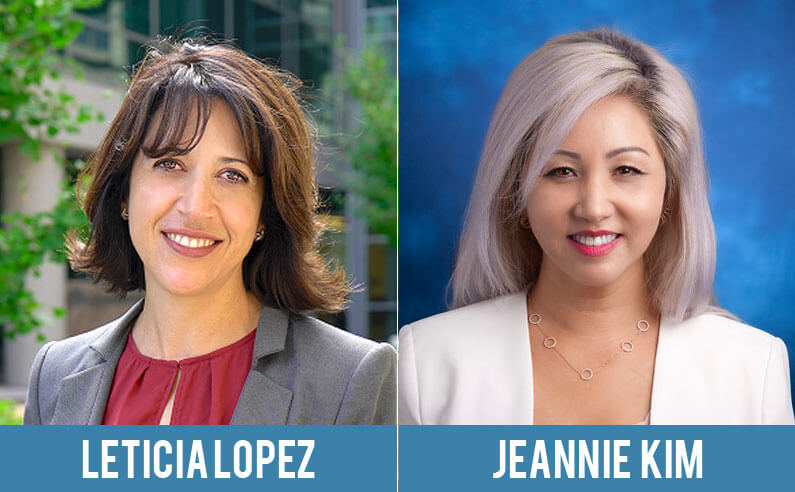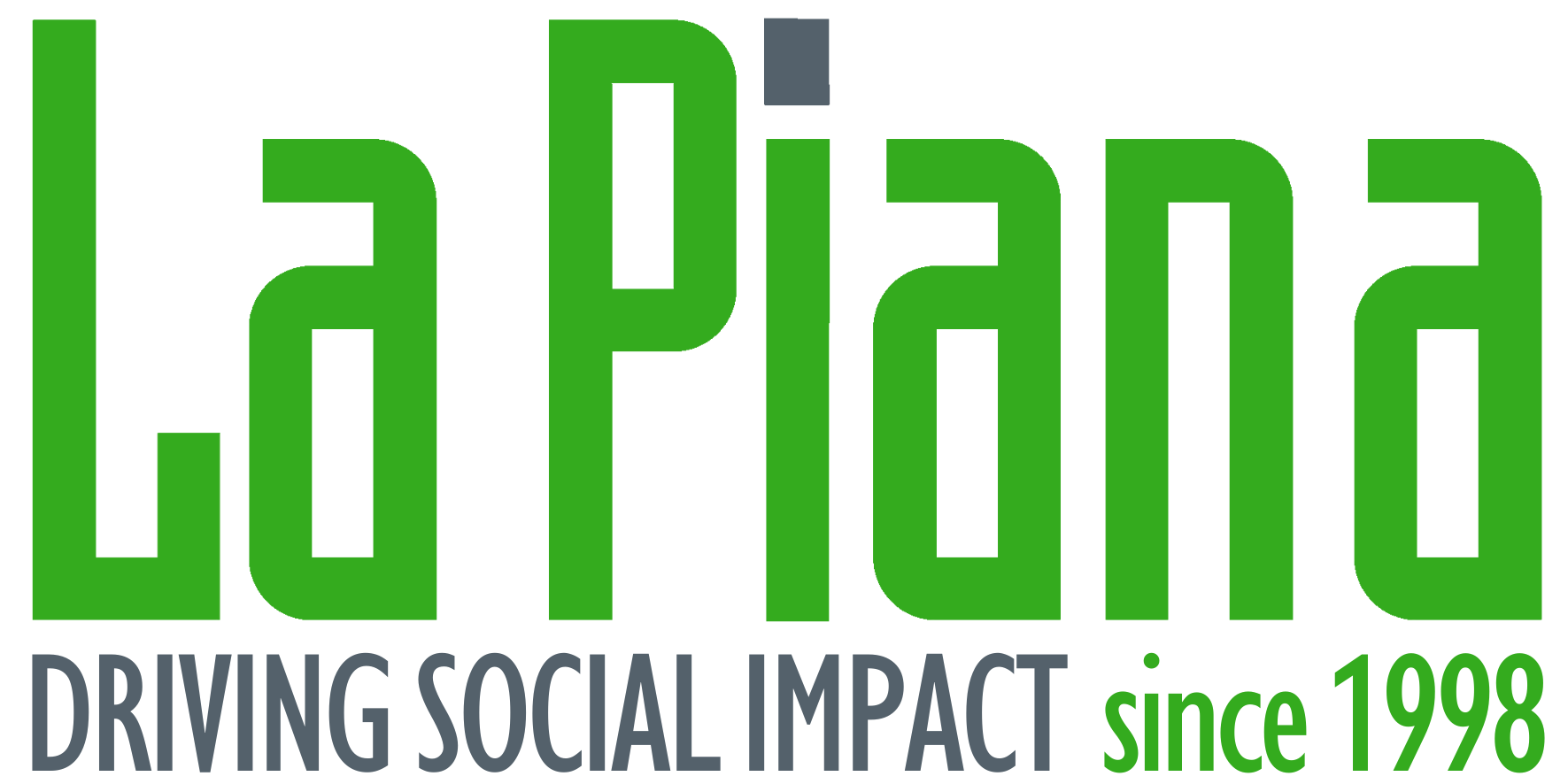Turning on a Dime: Shifting an Annual Conference to Virtual Overnight
AHSIE Interview with Leticia Lopez and Jeannie Kim, Alliance of Hispanic Serving Institution Educators
With Doug Green, Senior Consultant, La Piana Consulting

Jeannie Kim, Ph.D. serves as the Associate Vice Chancellor, Grants and Economic Development, at Riverside Community College District. Her colleague, Leticia Lopez, Ph.D. is the Program Manager for Hispanic Serving Institution (HSI) Initiatives at Mesa College in San Diego. Together they are the incoming co-presidents of the Alliance of Hispanic Serving Institution Educators (AHSIE). As a team, the two are fierce leaders with optimism, an inclination toward innovation, and a passion for equity – a combination that is arguably an ideal fit for the perfect storm of the current moment.
In addition to advocating for Latinx students in HSIs across the country, the two make a case for the track record and untapped potential of women of color to lead in a time of crisis. Dr. Kim notes that “Women of color are often pulled into a situation when things are dire and asked to lead in situations that no one else will touch. We have to support each other.” She goes on to share the importance of supporting women leaders of color to build both skills and the social capital needed to succeed. “We need to reproduce the systems that exist for the most fortunate among people who’ve traditionally been marginalized. That’s the equity solution,” Kim says.
In early March, as the coronavirus was beginning its rapid spread in the U.S., Dr. Kim and Dr. Lopez led AHSIE in taking the organization’s annual conference online in record time. I sat down with the two of them (virtually, of course!) to talk about how they made it happen and what they learned.
DG: Tell me a little about the conference. The conference is primarily for the managers and directors of programs for Latinx students at HSIs. Why is it important?
Dr. Lopez: You go into the work of being an HSI program manager or director seeking guidance and knowing that you need to develop skills, learn best practices, and build community with like-minded people.
Dr. Kim: As Director of Research at Cal State Fullerton when I first faced these challenges, I wanted to move my institution forward by tapping in to the AHSIE knowledge base. AHSIE gave me access to the expertise of those who had already been doing the work. The conference shares best practices and builds the connections needed that can drive the work forward for decades.
DG: Talk about the moment you decided to go virtual.
Dr. Kim: We knew that we needed to keep the conference alive in order to meet the need for sharing content. But there were naysayers, people who thought it couldn’t be done. We took a risk because we have to stand behind our mission and our vision for the HSI community.
Tuesday before the conference [scheduled to begin that Sunday] we met with our executive committee and decided to go forward with an in-person conference. But by that night I had changed my mind – and my vote – after reviewing the ever-evolving situation with COVID-19 and raised the idea of going virtual on the Shindig platform.
Dr. Lopez: It was interesting: Three of us were in a text thread watching South by Southwest and other major conferences cancel their in-person events. Dr. Kim said that if we don’t cancel the conference we will be seen as irresponsible in putting content and profit before the health of our members. Sure enough, by the end of that week, campuses across the country started cancelling programs and banning non-essential travel. The writing was on the wall.
Dr. Kim: On Wednesday, just four days before the conference was set to begin, we had a two-hour Council [board] meeting and the board gave the “green light” for a virtual conference. The decision was driven, in part, by concerns about revenue. I was looking at the budget. AHSIE stood to suffer a huge loss if we didn’t go forward with the conference. On Friday, we hosted three trainings for presenters on how to present on the Shindig platform for a conference that was set to start on Sunday.
Dr. Lopez: I tried keeping others on board, focused, and motivated. There were critics of the shift to an online conference, initially, even within AHSIE’s leadership. But eventually everyone came around. The training wasn’t as complex as you might imagine. Although it felt awkward at first, but after the training and some practice, navigating the Shindig system felt natural.
Dr. Kim: I had experience teaching online using many of the different platforms, but for others this was new territory. It’s important, if you are in that situation, to have a growth mindset. One of the keys to our success was a growth-minded approach, a willingness to take risks. Dr. Lopez has this mindset but it’s more unusual than you’d think. Many people are strongly averse to change
DG: What were the biggest challenges?
Dr. Lopez: One big challenge was getting – and maintaining – a good Internet connection. Having strong Wi-Fi was key. My MacBook had to be upgraded. For participants there were tough connection issues. There was a fair amount of inquiries where we advised individuals to restart, refresh, or choose another browser – we found using Chrome and not Explorer worked best. Many institutions also had firewalls that prevented their users from connect to Shindig.
Dr. Kim: There was a lot of fear. People said: ‘I’ve never done virtual. I can’t do it.’ Often, people didn’t know the right questions to ask. For many, it came down to a fear of failure – not wanting to be associated with something that didn’t work.
DG: How was the change communicated to conference participants? How was it received?
Dr. Kim: We sent an email to the participants. We considered phone calls but realized that people would ask questions that we didn’t have answers to. We didn’t want to just “make it up as we went.’ We were committed to delivering a uniform message even if we didn’t have all the answers. Things were moving very quickly. We discounted the conference fee by $100 (from $695 to $595) and once we developed a policy we stuck to our guns. At a moment like this it’s important to have rules to fall back on.
DG: What were the biggest changes that you noted in the experience of participants?
Dr. Kim. During the conference we had 200-400 participating at any given time. In some cases, colleagues came together to experience the conference together, creating community on their own campuses. On the last day we had 100 people participate in two workshops which is nearly unheard of for the last day of a conference.
The networking piece was the most difficult thing to replicate. If we had it all to do over again we would be much better prepared with community-building opportunities. We have the resources to recreate the networking component online but didn’t have the time nor capacity to execute properly.
Dr. Lopez: Participants in the conference got the knowledge transfer – people still love the content delivered. That was the most talked about piece. Feedback from participants included comments about missing the networking aspect of in-person conferences, but others said that it was amazing that AHSIE delivered the conference online on such short notice. Some were disgruntled by their experience online – partly, at least, due to their lack of technical capacity (either personally or institutionally). Getting everyone on Pacific Time was also a challenge (most of AHSIE’s current members are based on the West Coast). Still others commented that it was difficult to stay engaged in an online setting.
Dr. Kim: And, now they know how students are feeling right about now!
DG So, overall it was a great success for AHSIE. What were the primary “lessons learned?”
Dr. Lopez: We all need to level up and use the tech resources available to us. This experiment with a virtual conference showed how not ready our institutions are for this type of emergency. We need to embrace technology as a resource and that means both dealing with fears as well as practical challenges like bandwidth and firewalls. We see an equity crisis in not only the way technology is being delivered but in how it is being received. Just this past week on our college campus we were busy identifying students who don’t have laptops or Wi-Fi access, particularly in rural areas.
Dr. Kim: Institutions are completely unprepared for our current reality – and we need to adjust. Our experience pointed to the challenges of the future: the system is broken and needs to be overhauled. This realization creates a lot of fear. Higher education is a self-perpetuating machine that protects the status quo. We talk about equity and inclusion ad nauseum, but our systems are rooted in inequality. So not only are we dealing with the normal concerns about advancing the interests of Latinx students and adapting systems to support them, but we are also changing the minds of leaders who may resist change even in the best of circumstances.
Dr. Lopez: I started this HSI program director journey as a Professional Development Coordinator with the attitude that we can’t continue to deliver teaching and learning as we did twenty years ago. We need to look at what’s broken, where students are not receiving equitable learning opportunities, and address how we are failing them. As a result, our college HSI Research Analyst created our first-ever HSI & Equity dashboard. Dashboards like these are transformative: you can see where the most vulnerable students are falling behind. This gives all of us an opportunity to correct course. As we’re seeing with the coronavirus crisis, necessity is the mother of invention. It’s 2020 for goodness sake. The crisis is providing the kick in the pants that we all needed to leverage technology and deliver content virtually and effectively. Let’s, however, put it in the hands of everyone – equitably. Shifting mindsets and attitudes such as “I can’t do virtual meetings” or “I don’t teach or learn online” is not going to work if we are in higher education moving forward.
Dr. Kim: We have an unprecedented opportunity to change and level the playing field for institutions, programs, and students. It’s a time for people serving Latinx students to close the leadership gap and address critical equity issues. This is what AHSIE is all about. I like to say: get on board or get out of our way!
